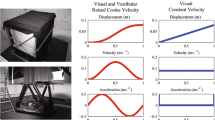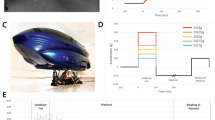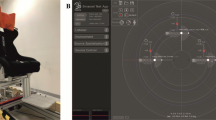Abstract
Both visual and inertial cues are salient in heading determination. However, optic flow can ambiguously represent self-motion or environmental motion. It is unclear how visual and inertial heading cues are determined to have common cause and integrated vs perceived independently. In four experiments visual and inertial headings were presented simultaneously with ten subjects reporting visual or inertial headings in separate trial blocks. Experiment 1 examined inertial headings within 30° of straight-ahead and visual headings that were offset by up to 60°. Perception of the inertial heading was shifted in the direction of the visual stimulus by as much as 35° by the 60° offset, while perception of the visual stimulus remained largely uninfluenced. Experiment 2 used ± 140° range of inertial headings with up to 120° visual offset. This experiment found variable behavior between subjects with most perceiving the sensory stimuli to be shifted towards an intermediate heading but a few perceiving the headings independently. The visual and inertial headings influenced each other even at the largest offsets. Experiments 3 and 4 had similar inertial headings to experiments 1 and 2, respectively, except subjects reported environmental motion direction. Experiment 4 displayed similar perceptual influences as experiment 2, but in experiment 3 percepts were independent. Results suggested that perception of visual and inertial stimuli tend to be perceived as having common causation in most subjects with offsets up to 90° although with significant variation in perception between individuals. Limiting the range of inertial headings caused the visual heading to dominate the perception.











Similar content being viewed by others
References
Acerbi L, Dokka K, Angelaki DE, Ma WJ (2018) Bayesian comparison of explicit and implicit causal inference strategies in multisensory heading perception. PLoS Comput Biol 14(7):e1006110. https://doi.org/10.1371/journal.pcbi.1006110 (PubMed PMID: 30052625; PubMed Central PMCID: PMCPMC6063401. epub 2018/07/28)
Angelaki DE, Gu Y, Deangelis GC (2011) Visual and vestibular cue integration for heading perception in extrastriate visual cortex. J Physiol 589(Pt 4):825–833. https://doi.org/10.1113/jphysiol.2010.194720 (PubMed PMID: 20679353; PubMed Central PMCID: PMCPMC3060362)
Butler JS, Smith ST, Campos JL, Bulthoff HH (2010) Bayesian integration of visual and vestibular signals for heading. J Vis 10(11):23. https://doi.org/10.1167/10.11.23 (PubMed PMID: 20884518)
Butler JS, Campos JL, Bulthoff HH, Smith ST (2011) The role of stereo vision in visual-vestibular integration. See Perceiving 24(5):453–470. https://doi.org/10.1163/187847511X588070 (PubMed PMID: 21888763)
Chen X, Deangelis GC, Angelaki DE (2013) Diverse spatial reference frames of vestibular signals in parietal cortex. Neuron 80(5):1310–1321. https://doi.org/10.1016/j.neuron.2013.09.006 (PubMed Central PMCID: PMCPMC3858444)
Crane BT (2012) Direction specific biases in human visual and vestibular heading perception. PLoS One 7(12):e51383. https://doi.org/10.1371/journal.pone.0051383 (epub 12/7/12. PubMed PMID: 23236490)
Crane BT (2014) Human visual and vestibular heading perception in the vertical planes. J Assoc Res Otolaryngol 15(1):87–102. https://doi.org/10.1007/s10162-013-0423-y (epub 2013/11/20. PubMed PMID: 24249574)
Crane BT (2015) Coordinates of human visual and inertial heading perception. PLoS One 10(8):e0135539. https://doi.org/10.1371/journal.pone.0135539 (PubMed PMID: 26267865; PubMed Central PMCID: PMCPMC4534459)
Crane BT (2017) Effect of eye position during human visual-vestibular integration of heading perception. J Neurophysiol. https://doi.org/10.1152/jn.00037.2017 (PubMed PMID: 28615328)
Cuturi LF, Macneilage PR (2013) Systematic biases in human heading estimation. PLoS One 8(2):e56862. https://doi.org/10.1371/journal.pone.0056862 (PubMed PMID: 23457631; PubMed Central PMCID: PMC3574054)
de Winkel KN, Weesie J, Werkhoven PJ, Groen EL (2010) Integration of visual and inertial cues in perceived heading of self-motion. J Vis 10(12):1. https://doi.org/10.1167/10.12.1 (PubMed PMID: 21047733. epub 2010/11/05)
de Winkel KN, Katliar M, Bulthoff HH (2015) Forced fusion in multisensory heading estimation. PLoS One 10(5):e0127104. https://doi.org/10.1371/journal.pone.0127104 (PubMed PMID: 25938235; PubMed Central PMCID: PMCPMC4418840)
de Winkel KN, Katliar M, Bulthoff HH (2017) Causal inference in multisensory heading estimation. PLoS One 12(1):e0169676. https://doi.org/10.1371/journal.pone.0169676 (PubMed PMID: 28060957; PubMed Central PMCID: PMCPMC5218471)
Fetsch CR, Turner AH, Deangelis GC, Angelaki DE (2009) Dynamic re-weighting of visual and vestibular cues during self-motion perception. J Neurosci 29(49):15601–15612. https://doi.org/10.1523/JNEUROSCI.2574-09.2009 (PubMed PMID: 20007484)
Fetsch CR, Deangelis GC, Angelaki DE (2010) Visual-vestibular cue integration for heading perception: applications of optimal cue integration theory. Eur J Neurosci 31(10):1721–1729. https://doi.org/10.1111/j.1460-9568.2010.07207.x (PubMed PMID: 20584175; PubMed Central PMCID: PMC3108057)
Fetsch CR, Pouget A, DeAngelis GC, Angelaki DE (2012) Neural correlates of reliability-based cue weighting during multisensory integration. Nat Neurosci 15(1):146–154. https://doi.org/10.1038/nn.2983 (PubMed PMID: 22101645. epub 2011/11/22)
Gibson JJ (1950) The perception of the visual world. Houghton Mifflin, Boston, 235 p
Grabherr L, Nicoucar K, Mast FW, Merfeld DM (2008) Vestibular thresholds for yaw rotation about an earth-vertical axis as a function of frequency. Exp Brain Res 186(4):677–681 (PubMed PMID: 18350283)
Gu Y, DeAngelis GC, Angelaki DE (2007) A functional link between area MSTd and heading perception based on vestibular signals. Nat Neurosci 10(8):1038–1047 (PubMed PMID: 17618278)
Gu Y, Angelaki DE, Deangelis GC (2008) Neural correlates of multisensory cue integration in macaque MSTd. Nat Neurosci 11(10):1201–1210. https://doi.org/10.1038/nn.2191 (PubMed PMID: 18776893; PubMed Central PMCID: PMC2713666)
Guedry FE Jr (1974) Psychophysics of vestibular sensation. In: Kornhuber HH (ed) Handbook of sensory physiology, vol VI/2. Springer, New York, pp 3–154
Knill DC, Pouget A (2004) The Bayesian brain: the role of uncertainty in neural coding and computation. Trends Neurosci 27(12):712–719 (PubMed PMID: 15541511)
Körding KP, Beierholm U, Ma WJ, Quartz S, Tenenbaum JB, Shams L (2007) Causal inference in multisensory perception. PLoS One 2(9):e943. https://doi.org/10.1371/journal.pone.0000943 (PubMed PMID: 17895984; PubMed Central PMCID: PMCPMC1978520)
MacNeilage PR, Banks MS, DeAngelis GC, Angelaki DE (2010) Vestibular heading discrimination and sensitivity to linear acceleration in head and world coordinates. J Neurosci 30(27):9084–9094. https://doi.org/10.1523/JNEUROSCI.1304-10.2010 (PubMed PMID: 20610742; PubMed Central PMCID: PMC2914270. epub 2010/07/09)
Ramkhalawansingh R, Butler JS, Campos JL (2018) Visual-vestibular integration during self-motion perception in younger and older adults. Psychol Aging 33(5):798–813. https://doi.org/10.1037/pag0000271 (PubMed PMID: 29999391. epub 2018/07/13)
Recanzone GH (2009) Interactions of auditory and visual stimuli in space and time. Hear Res 258(1–2):89–99. https://doi.org/10.1016/j.heares.2009.04.009 (epub 2009/04/28. PubMed PMID: 19393306; PubMed Central PMCID: PMCPMC2787663)
Roditi RE, Crane BT (2012) Directional asymmetries and age effects in human self-motion perception. J Assoc Res Otolaryngol 13(3):381–401 (PubMed PMID: 22402987)
Sato Y, Toyoizumi T, Aihara K (2007) Bayesian inference explains perception of unity and ventriloquism after effect: identification of common sources of audiovisual stimuli. Neural Comput 19(12):3335–3355. https://doi.org/10.1162/neco.2007.19.12.3335 (PubMed PMID: 17970656. epub 2007/11/01)
Telford L, Howard IP, Ohmi M (1995) Heading judgments during active and passive self-motion. Exp Brain Res 104(3):502–510 (PubMed PMID: 7589301)
Thurlow WR, Jack CE (1973) Certain determinants of the “ventriloquism effect”. Percept Motor Skills 36(3):1171–1184. https://doi.org/10.2466/pms.1973.36.3c.1171 (PubMed PMID: 4711968. epub 1973/06/01)
Warren WH Jr, Hannon DJ (1988) Direction of self-motion perceived from optical flow. Nature 336:162–163
Witkin HA, Wapner S, Leventhal T (1952) Sound localization with conflicting visual and auditory cues. J Exp Psychol 43(1):58–67 (epub 1952/01/01. PubMed PMID: 14907992)
Wozny DR, Beierholm UR, Shams L (2010) Probability matching as a computational strategy used in perception. PLoS Comput Biol 6(8):e1000871. https://doi.org/10.1371/journal.pcbi.1000871 (PubMed PMID: 20700493; PubMed Central PMCID: PMCPMC2916852)
Yang L, Gu Y (2017) Distinct spatial coordinate of visual and vestibular heading signals in macaque FEFsem and MSTd. Elife 6:e29809. https://doi.org/10.7554/eLife.29809 (PubMed PMID: 29134944; PubMed Central PMCID: PMCPMC5685470)
Acknowledgements
The authors would like to thank Kyle Critelli for technical assistance as well as editing the final paper. Grant support was provided by NIDCD R01 DC013580.
Author information
Authors and Affiliations
Corresponding author
Additional information
Publisher’s Note
Springer Nature remains neutral with regard to jurisdictional claims in published maps and institutional affiliations.
Rights and permissions
About this article
Cite this article
Rodriguez, R., Crane, B.T. Effect of range of heading differences on human visual–inertial heading estimation. Exp Brain Res 237, 1227–1237 (2019). https://doi.org/10.1007/s00221-019-05506-1
Received:
Accepted:
Published:
Issue Date:
DOI: https://doi.org/10.1007/s00221-019-05506-1




